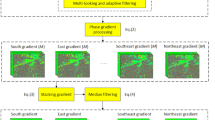Abstract
With the rapid growth of the construction industry, precise and efficient monitoring of building deformation has become a crucial factor in ensuring their secure construction and stable operation. The frequent occurrence of occlusion and diffraction errors in satellite signals caused by high-rise buildings has emerged as a primary challenge that constrains the accuracy of positioning in deformation monitoring by BeiDou Navigation Satellite (BDS). To solve the problems, this study proposes an elevation mask angle modeling method of satellite signal occlusion based on azimuth rounding and applies it to real-time BDS building deformation monitoring and positioning algorithm. The proposed approach involves defining a particular subset of integer azimuth and elevation angles, followed by utilizing the minimum elevation angle from this subset to develop a model for the azimuth-dependent elevation mask angle. We aimed to develop an elevation angle mask model using a conventional approach, and the model can be utilized to focus on non-line-of-sight (NLOS) and multipath signals and attenuate their impact on positioning accuracy by reducing their weight. The experimental results show that the elevation angle mask model can be easily completed by using the observation data of BDS satellites in a single day, and its use can make the number of effective satellites involved in the calculation of real-time deformation monitoring of BDS more accurate and reliable. The root mean square (RMS) of positioning results including float solutions was increased respectively by 91.1%, 93.3%, and 72.7% in the direction of East-North-Up (ENU), and the RMS of results with fixed ambiguity was increased by 6.9%, 10.0%, and 29.5%, respectively. Therefore, it can be concluded that the elevation mask angle modeling algorithm is convenient to realize and can significantly improve the performance of deformation monitoring results by BDS.






Similar content being viewed by others
References
Afrouz SG, Razavi MR, Pourkand A, Wilson CMD (2019) Dynamic displacement of an aluminum frame using close range photogrammetry. Buildings 9:176. https://doi.org/10.3390/buildings9080176
Chang XW, Yang X, Zhou T (2005) MLAMBDA: a modified LAMBDA method for integer least-squares estimation. J Geodesy 79:552–565. https://doi.org/10.1007/s00190-005-0004-x
Dong D, Wang M, Chen W, Zeng Z, Song L, Zhang Q, Cai M, Cheng Y, Lv J (2016) Mitigation of multipath effect in GNSS short baseline positioning by the multipath hemispherical map. J Geodesy 90:255–262. https://doi.org/10.1007/s00190-015-0870-9
Groves PD (2011) Shadow matching: a new GNSS positioning technique for urban canyons. J Navigation 64:417–430. https://doi.org/10.1017/S0373463311000087
Han JQ, Huang GW, Zhang Q, Tu R, Du Y, Wang XL (2018) A new azimuth-dependent elevation weight (ADEW) model for real-time deformation monitoring in complex environment by multi-GNSS. Sensors. https://doi.org/10.3390/s18082473
Hartinger H, Brunner FN (1999) Variances of GPS phase observations: The SIGMA-e model. GPS Solut 2:35–43. https://doi.org/10.1007/PL00012765
Li P, Zhang XH, Guo F (2017) Ambiguity resolved precise point positioning with GPS and BeiDou. J Geodesy 91:25–40. https://doi.org/10.1007/s00190-016-0935-4
Li HY, Nie GG, Chen DZ, Wu SG, Wang KZ (2019) Constrained MLAMBDA method for multi-GNSS structural health monitoring. Sensors. https://doi.org/10.3390/s19204462
Luo X, Mayer M (2009) Heck B Improving the stochastic model of GNSS observations by means of SNR-based weighting. Springer, Berlin, pp 725–734
Peyraud S, Betaille D, Renault S, Ortiz M, Mougel F, Meizel D, Peyret F (2013) About non-line-of-sight satellite detection and exclusion in a 3D map-aided localization algorithm. SENSORS 13:829–847. https://doi.org/10.3390/s130100829
Ragheb AE, Clarke PJ, Edwards SJ (2007) GPS sidereal filtering: coordinate- and carrier-phase-level strategies. J Geodesy 81:325–335. https://doi.org/10.1007/s00190-006-0113-1
Sun J, Manzanarez R, Nader M (2004) Suspension cable design of the new san Francisco–Oakland bay bridge. J Bridge Eng 9:101–106. https://doi.org/10.1061/(ASCE)1084-0702(2004)9:1(101)
Takasu T (2009) RTKLIB: open source program package for RTK-GPS. Proceedings of the FOSS4G
Teunissen PJG (1995) The least-squares ambiguity decorrelation adjustment: a method for fast GPS integer ambiguity estimation. J Geodesy 70:65–82. https://doi.org/10.1007/BF00863419
Teunissen PJG (1999) An optimality property of the integer least-squares estimator. J Geodesy 73:587–593. https://doi.org/10.1007/s001900050269
Wang L, Groves PD, Ziebart MK (2012) Multi-constellation GNSS performance evaluation for urban canyons using large virtual reality city models. J Navigation 65:459–476. https://doi.org/10.1017/S0373463312000082
Xi RJ, Jiang WP, Meng XL, Zhou XH, He QY (2018) Rapid initialization method in real-time deformation monitoring of bridges with triple-frequency BDS and GPS measurements. ADV SPACE RES 62:976–989. https://doi.org/10.1016/j.asr.2018.06.018
Yakushenkov YG, Arefiev AA, Zdorkin YP (1995) Laser system for building deformation measurements. In: Proceedings of the smart structures: optical instrumentation and sensing systems, Munich, Germany, pp. 79–86, doi https://doi.org/10.1117/12.221106.
Yu JY, Meng XL, Yan BF, Xu B, Fan Q, Xie YL (2020) Global navigation satellite system-based positioning technology for structural health monitoring: a review. Struct Control Hlth. https://doi.org/10.1002/stc.2467
Zhang Z, Yuan H, Li B, He X, Gao S (2021) Feasibility of easy-to-implement methods to analyze systematic errors of multipath, differential code bias, and inter-system bias for low-cost receivers. GPS Solutions 25:116
Acknowledgements
This work is partly supported by the National Natural Science Foundation of China (Grant Nos.: 41674034, 41974032, 11903040), the Chinese Academy of Sciences (CAS) program of “Western Youth Scholar” (Grant Nos.: Y712YR4701, Y916YRa701, XAB2019B14).
Author information
Authors and Affiliations
Corresponding author
Ethics declarations
Competing interest
The authors declare that they have no known competing financial interests or personal relationships that could have appeared to influence the work reported in this paper.
Rights and permissions
Springer Nature or its licensor (e.g. a society or other partner) holds exclusive rights to this article under a publishing agreement with the author(s) or other rightsholder(s); author self-archiving of the accepted manuscript version of this article is solely governed by the terms of such publishing agreement and applicable law.
About this article
Cite this article
Junqiang, H., Rui, T., Xiaochun, L. et al. An elevation mask modeling method based on azimuth rounding for monitoring building deformation. Acta Geod Geophys 58, 273–283 (2023). https://doi.org/10.1007/s40328-023-00413-y
Received:
Accepted:
Published:
Issue Date:
DOI: https://doi.org/10.1007/s40328-023-00413-y




